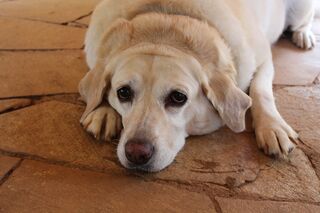Coronavirus Disease 2019
During the Lockdown Certain Dog Breeds Have Gotten Plump
The Covid-19 lockdown has resulted in some dog breeds growing markedly fatter.
Posted November 11, 2020 Reviewed by Gary Drevitch

I can certainly attest to the fact that one of the outcomes of the various lockdowns and movement limitations because of the Covid-19 virus has been weight gain. In my own case, since March, I have put on nearly 10 pounds. It appears that I am not alone: In a poll of more than 1,000 WebMD readers, nearly half of the women and almost one-quarter of the men said they’d gained weight “due to COVID restrictions.” Now new research indicates that dogs have also been putting on weight during the lockdown, and that certain breeds are much more susceptible to these weight gains than others.
This research comes out of the UK and the study was conducted by investigators at Dog Friendly Retreats (a platform that normally provides information on holiday destinations where pet dogs traveling with the family are accepted). The study involved a survey of more than 1,700 dog owners. The information was taken over the period of several months when the UK was experiencing a national lockdown, which was then followed by a post lockdown stretch of time that resulted in millions of people remaining in their homes to prevent the spread of the novel coronavirus.
Maintaining a healthy weight is often as difficult for pet dogs as it is for people. According to data provided by the Pet Food Managers Association, 51 percent of dogs in the UK are already overweight so putting on even a few extra pounds could be problematic for their health. This new survey of weight gain in dogs during the lockdown indicates that the average dog has gained 2.7 pounds during its time sheltering at home. However one surprise is that the amount of weight gained varies among dog breeds.
According to the data that was collected, the 10 dog breeds that have gained the most weight this year are:
- Labrador Retrievers + 4.1 lb on average
- French Bulldogs + 3.8 lb on average
- Daschunds + 3 lb on average
- Beagles + 2.1 lb on average
- German Shepherds + 2 lb on average
- Cockapoos + 1.9 lb on average
- Cocker Spaniels + 1.5 lb on average
- West Highland Terrier + 1.2 lb on average
- Shih Tzu + 1 lb on average
- Chihuahua + 0.5 lb on average
For some of the smaller breeds, these weight gains are highly significant. For example, for the French bulldog, whose average weight is about 24 pounds, the 3.8-pound weight gain corresponds to a 16% increase in body mass. Furthermore, it is important to note that this data was gathered over a period of only a few months, and it would be reasonable to expect that if Covid-19 restrictions extended out for a full year we would be looking at weight gains that could be three or four times as large.
The researchers went on to ask dog owners about the reasons they believe their dog had gained weight. More than half of respondents (52%) felt that it was simply because they were spending more time with their dog. This is something that I can understand since I usually keep a pocket full of treats and every now and then, when I am home with my dogs, I will ask them to do something and then reward them with a treat. So spending more time with the dogs means more treats as rewards during the day which ultimately could translate into added pounds.
Approximately one third (33%) of dog owners believe that their dog's weight gain was due lack of exercise because the number of walks that they take their dogs daily have now been severely reduced.
One interesting finding in this research was a clear correlation between dogs living in households with children and the dogs' tendency to maintain or lose weight this year. Approximately three fifths (59%) of the dogs that didn't put on weight during this time period were living in a household with children.
The recommended steps for avoiding weight gain in dogs are not much different than it is for humans. For example, measuring food portions is a start. Of course, the best advice is to give your pet additional exercise, which can be done indoors, even if you can't get out to walk your dog. This may involve playing fetch or tug-of-war, or if these data are to be believed, having children or borrowing them to interact with your dog seems to work as well.
Copyright SC Psychological Enterprises Ltd. May not be reprinted or reposted without permission


